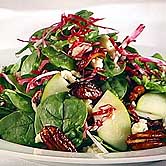
THURSDAY, Nov. 29 (HealthDay News) — You’d like a salad? Want some fries with that?
A new study shows that providing more menu options on a fast-food menu doesn’t mean the average diner chows down fewer calories.
Researchers found that although there has been a 53 percent increase in the total number of menu offerings over the last 14 years, the average calorie content of foods sold by eight of the major U.S. fast-food chains has not changed much.
Part of the problem is that some of the highest-calorie foods are masquerading as healthy, said Katherine Bauer, lead author of the study and an assistant professor in the department of public health at Temple University, in Philadelphia. “Entree salads, which are increasing in number, can be bad, too. With fried chicken on top and regular dressing, they can have more calories than a burger.”
The study, published in the November issue of the American Journal of Preventive Medicine, analyzed menu offerings and their nutritional value from McDonald’s, Burger King, Wendy’s, Taco Bell, KFC, Arby’s, Jack in the Box and Dairy Queen.
A nutrition expert who was not involved with the study agreed with the study findings.
“Fast food may be offering more so-called ‘healthy’ alternatives but not necessarily fewer calories,” said Lona Sandon, an assistant professor of clinical nutrition at the University of Texas Southwestern Medical Center at Dallas.
In the last two years studied — 2009 and 2010 — the average lunch or dinner entree had 453 calories, while the average side dish had 263 calories.
While the researchers didn’t see a significant change in the median calorie content of entrees and drinks, they found a small increase in the calories found in condiments and desserts.
According to the study authors, fast food accounts for about 15 percent of Americans’ calorie intake, up from about 4 percent in the late 1970s. They said that a recent survey found that 28 percent of adults had fast food two or more times a week, and 40 percent of high school students consume fast food on any given day.
“It’s not like one fast-food meal is going to be a problem,” Bauer said. “But a good proportion of teenagers are eating fast food three to four times a week.”
Rather than blaming Americans for a lack of willpower, Bauer said that they’re overexposed to places where most of the available options are unhealthy, high-calorie foods. “We’ve created environments where it’s really impossible to succeed,” she said.
Data for the study were taken from the University of Minnesota Nutrition Coordinating Center Food and Nutrient Database, which includes menu items available at 22 U.S. fast-food restaurant chains.
The menus included all foods, drinks, desserts and condiments — such as salad dressing, ketchup, mustard, mayonnaise, jelly, salsa, tartar sauce and croutons — for lunch and dinner. Side dishes included french fries, other fried foods, soups and chili, breads, non-fried potatoes, and other foods such as nachos, baked beans and green beans.
Sandon said she thinks part of the problem is that people don’t understand calories or have a good idea of how many calories they should be taking in every day. “People also tend to overestimate how many calories they burn when they exercise,” she added.
Why wouldn’t the availability of more healthy food choices create a decrease in the total calories consumed in fast-food restaurants? Sandon said that while posting the calorie numbers are helpful for people who are eager to manage their health and weight, not everyone reacts that way. “Some people want the most calories for their dollar,” she said.
Sandon also thinks just the broader range of menu options may be part of the problem. “When people have more choices they may order more,” she said.
One limitation of the study, Sandon noted, is that the researchers only included data up to 2010. She said many of the fast-food chains seem to have decreased calorie counts and expanded healthy menu options only in the last two years.
Sandon suggested consumers try to eat home more often. And when they find themselves at a fast-food restaurant, she recommended that they order the smallest size available, even if it’s from the children’s menu.
“And remember: Just because it’s healthful and nutritious, it doesn’t mean it doesn’t have calories,” Sandon said.
More information
Learn more about healthy eating from the U.S. Department of Health and Human Services.

